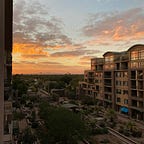Phoenix stalls again on traffic safety and pedestrian deaths
Vision Zero calls on cities to develop a comprehensive set of policies aimed at reducing and eventually eliminating pedestrian deaths, resulting in safer streets for all road users. So why did a City Council with power over some of the most dangerous roads in the country vote against studying a plan for Phoenix?
Following up on my previous visit to a Phoenix Complete Streets working group, I attended this past Tuesday’s City Council policy meeting. The council-members debated whether to direct city staff to study Vision Zero and what a plan to apply those safety and design principles might look like in this 517 square mile, largely car-oriented city. After presentations by staff explaining the benefits of Vision Zero, comments from residents, and discussion amongst City Council led by new mayor Kate Gallego, the plan failed to move forward, losing a 4 – 4 vote.
Much of what I heard from both the elected officials and people from the general public mirrored arguments for and against changes to the status quo of car dominance in cities worldwide. True, Phoenix has a somewhat unusual desert climate and an especially stark lack of pre-automobile built environment, but it developed in a similar pattern as other Sunbelt cities that grew rapidly in the decades following World War II.
A central danger of that development style is over-reliance on over-wide multilane roads. Call them arterials or call them stroads, these roads are designed like highways to move cars at high speed but through urbanized areas where people live and work. Pedestrian deaths and injuries are heavily concentrated on arterials because the wider and more numerous lanes cause people to drive faster, greatly increasing the risk to people walking or biking along high-speed roads.
Dangerous arterials form the main boxes of Phoenix’s graph paper-style street grid, creating significant barriers for people trying to venture out of their 1.5 mile square “home tile” on foot or bike. For example, one resident described the difficulty of walking in her fairly affluent north-central Phoenix neighborhood, bounded by Northern and Glendale Avenues, and “the 7's” as they’re known. Though harms from traffic and associated air pollution are heavily concentrated in poorer communities, car dependence degrades quality of life across the entire region.
Phoenix city staff recognized the correlation between wide lanes on arterials, some of which even lack lighting or sidewalks on both sides, and danger to pedestrians. One suggested Vision Zero policy would plan to automatically re-stripe roads with narrower lanes when they receive maintenance, which could gradually increase traffic safety citywide.
Councilmen Waring and DiCiccio seemed at times disconnected from the purpose of the meeting or the policies actually up for discussion. After DiCiccio argued at length against a blanket 25-mph limit on all city streets, claiming such a policy would cause congestion (probably not) or stifle economic activity (traffic correlates to more productive areas, not less), Councilwoman Guevara clarified with staff that nobody proposed that.
Waring was quick to misrepresent the pedestrian fatality statistics and assert that most of the people killed were intoxicated and not in a crosswalk. It implied that pedestrian deaths are an issue of “personal responsibility,” probably inevitable, and at any rate not an issue local government has any duty to address. Waring’s insistence on blaming the victims of traffic violence was a slap in the face to the many supporters of Vision Zero who urged the officials to avoid just that, and to the mayor, who reminded everyone that children are disproportionately hurt and killed by speeding cars.
Some comments were especially callous in their dismissive attitude toward the suffering that traffic deaths and injury cause, essentially boiling down to “sorry if you lost a family member, but we need money for potholes.” It’s understandable that representatives and residents of areas of the city where every daily need requires a car would prioritize road maintenance like expensive repaving or stoplight projects, but it’s crucial to show how safer streets and increased mobility choice benefit everyone.
Councilman Nowakowski, who represents downtown and parts of working class West Phoenix, appeared fairly supportive or less critical of the goals of Vision Zero and understood how it could help protect his constituents. However, he also expressed concern that some proponents of the plan put too much emphasis on police enforcement of driving and pedestrian laws, which is a far different proposal in poorer, less white neighborhoods than in wealthier districts of Phoenix.
Though it would have been preferable for Nowakowski to vote for Vision Zero and work to ensure the plan is not overly punitive, I agree that a focus on enforcement misunderstands the cause of unsafe traffic while ignoring long and continued over-policing and harassment of marginalized people under the guise of public safety. Drivers disregarding speed limits is a systemic problem solved with road design, not spotty and often financially exploitative ticketing.
Moving forward, we can only continue to raise the alarm about the public health crisis of road safety to make sure leaders in Phoenix and cities across the country can’t ignore this constant, but largely preventable, risk.
